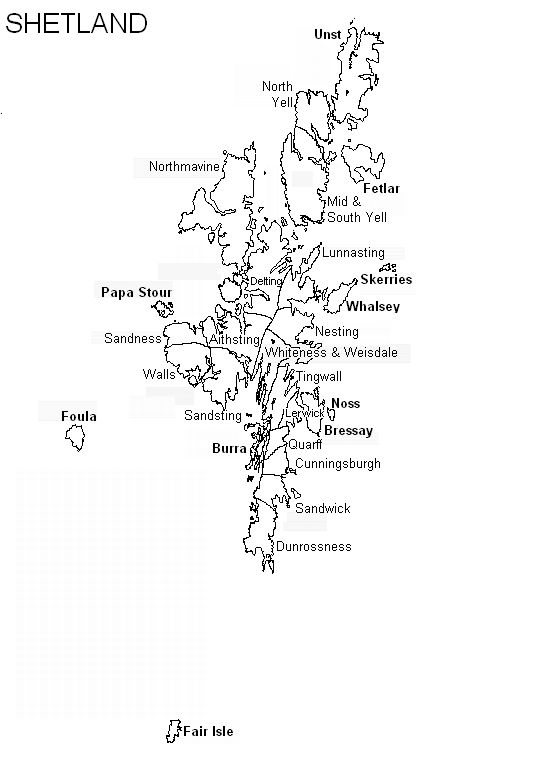| |
This
overview is based on distinctions registered in Shetland Scots as of
the end of the 19th century by Jakob Jakobsen and presented in his
"Etymological Dictionary of the Norn Language in Shetland", v.I, p. LIX, with some additions.
Most of the features mentioned below are undoubtedly of Norn origin, although influences from Scots may also be seen in between. (Additions to this list are more than welcome.)
1. Eastside, North Islands, South Shetland
1.1. palatalisation (rather irregular) ll,rl
> ļļ, nn,rn > ņņ, tt > itt, ţţ: falla > faļļj, fäļļ,
ullar- > oļļa, millum > melan, meļļan, gott &ht; goitt, goţţ, occasionally in the initial
(prevocalic) position: fleygja > fļog, lœkr > log,ljog
- hann > häņņ, brenna >
breņņǝk, andi > äņdi, but banna
> bann
1.2. ON hv,kv, Eng. qu-,wh- > w: hvalr > hwāl, hvammr >
hwam, kvisa > hwis, Eng. quite,white > white
1.3. In Dunrossness (South Shetland) the original ð is occasionally preserved as [ð] or [þ]: eið > eð, mið > mið, kóð > køð,køþ, seiðr > seð,seþ
1.A. North Islands, especially Unst and Yell
1.A.1. ā > â, a somewhat diphtongized sound approaching the
Faroese á [ɔa]: âli 'lamb' =
āli,
brând = brand, tând = tānd;
1.A.2. de Herra in Yell (as well in several other places all over Shetland): -ingr,-ungr > -iŋ:
buliŋ = būrək
< *buringr, buliŋ,boliŋ = bulin,
drøliŋ = drø:lin < ON drafli + L.Sc. drulie;
1.A.3. In de Herra in Yell sporadically ð > þ: kø:þ = kø:d
< kóð, tøþələp
= tudelep < *tǫðulaupr
1.A.4. hv, kv > hw, in North islands (Yell) occasionally to sw: hvalr > hwal, kví > hwi,kwi, hvammr > swam
2. Westside (neighbourhood of Sandness), Foula
2.1. ε,æ are occasionally pronounced more open than
usual.
2.2. ON á
> wo: á > wo, tár >
twor, fá > fwo
2.3. [y] is often present where Mainland
has [ø]: bryni (brøni) < ON *brýn-; ryni (røni) <
ON hraun, tryni (trøni) < ON trýni;
2.4. (also in part of South Shetland, especially Conningsburgh and Quarf) hv,kv, Eng. qu-,wh- > kw: kwolvin < kálf(r)inn, hvalr > kwal, kví > kwi, hverjum > kvara, hvar > quar (Hildina),
Eng. quite,white > quite, but hvítr > whit-, hvern > whaar (Hildina)
2.5. Instead of the palatal utterance of ll,nn, the change ll, nn > dl, dn is present in
many cases (where Mainland Norn has ņņ/rn and ļļ/rl): fall > fadl, bolla- > bodli-, kunnr > kodn,kodden, horn > hoden.
It has to be added that the palatal pronunciation of ll,nn has
found its way to this dialect too, cf. !!!
2.6. Likewise, the long -tt- is never palatalised and does not add -i- to the preceding vowel either: gott > gott.
2.7. The initial h- is often omitted: hennar >
ednar, henni > ende, hǿsta > osta
2.8. Some pronunciation differences: bjadni < barn(it), cf. Shetland mainland boņņ.

|
|


